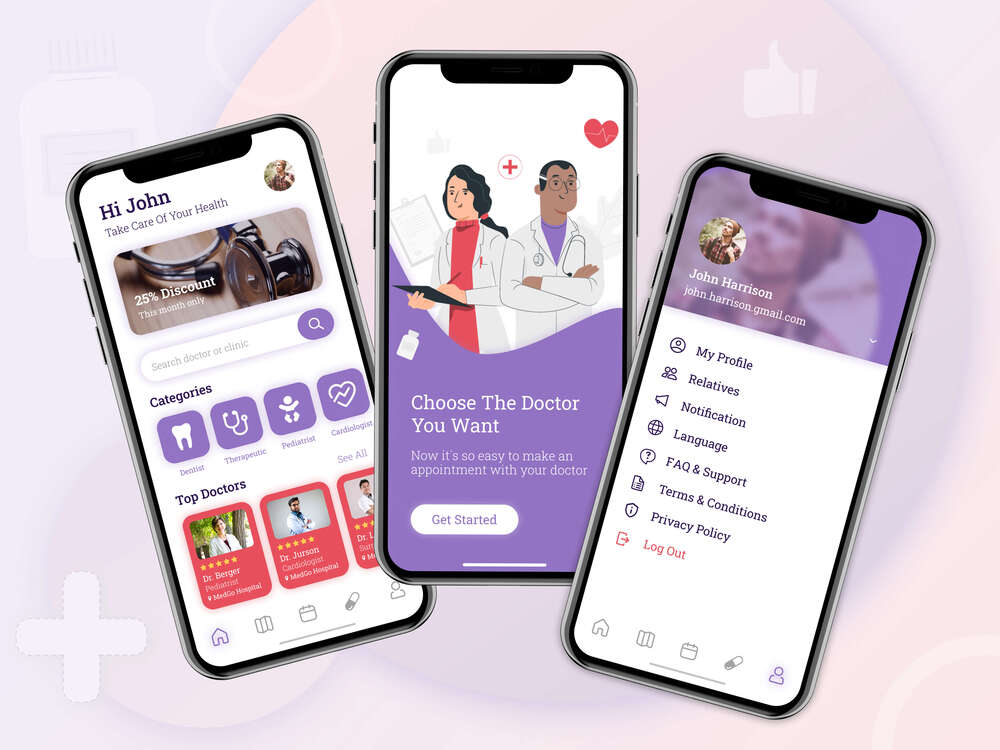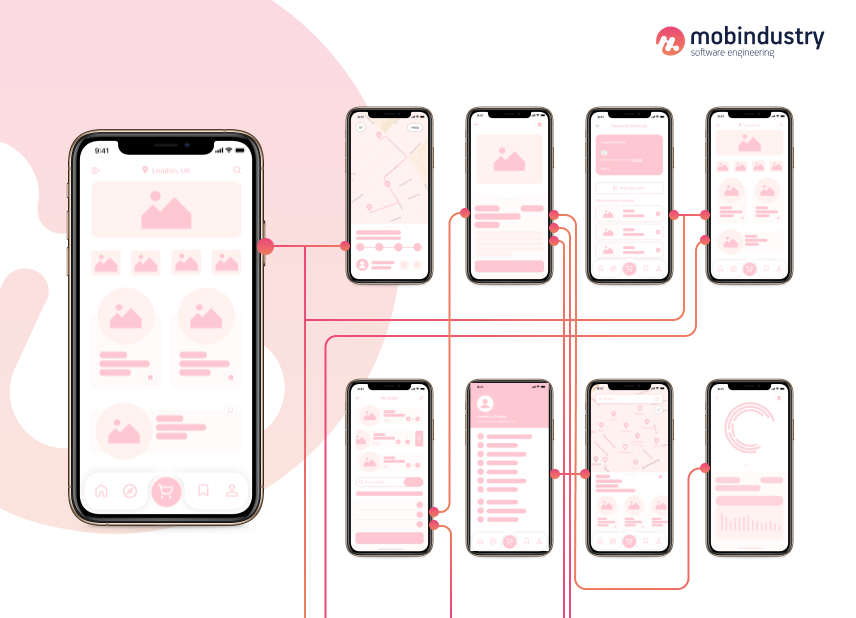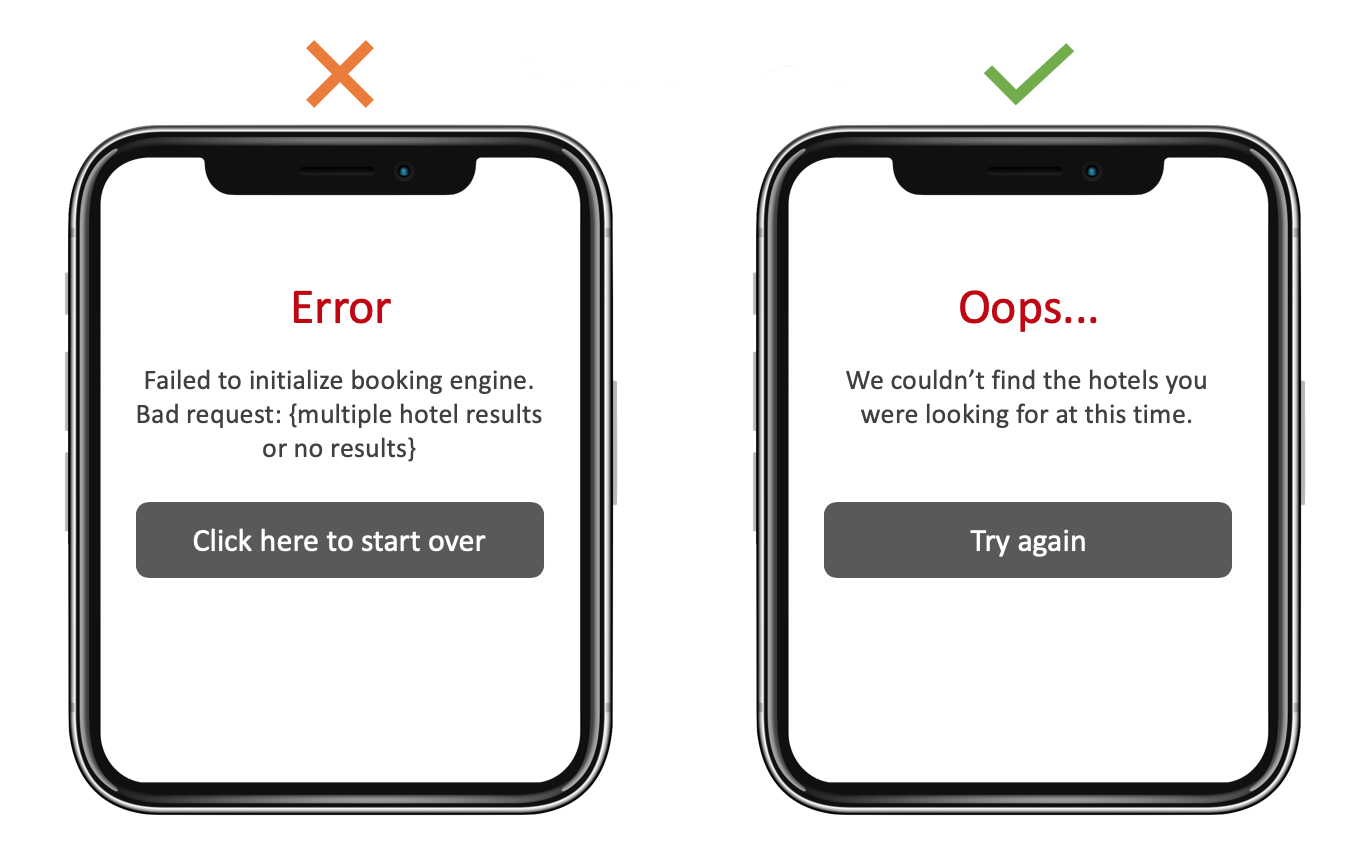Digital Product Design Team: Roles And Responsibilities
A design can make or break a product, as it reflects the needs of your target audience and shows how your product can meet these needs. Learn how to build a strong product team and maximize your product’s success.
When we hear the word “design,” we often think of visual aesthetics. Although this is also very important, product design is much more than that.
Product design is a specific way a product works and leads users to fulfill their needs in the most convenient, short, and pleasant way. Thus, a business reaches its goals by drawing attention to its service, selling products through an app, or monetizing its content.
According to the famous McKinsey report, businesses that focus on design, on average, generate 32% more revenue and 56% more shareholder returns. Design impacts all the key areas associated with business success, like:
- Customer satisfaction
- Product usability
- Brand awareness
- Revenue
- Conversion rates
- Employee productivity
- Customer loyalty
- User retention
In this article, you’ll learn how to build a strong product design team that will help you achieve your business goals and create a converting and efficient product. We’ll talk about team goals, structure, and roles of each team member.
What is a product design team?
A product design team is a group of professionals who can tie together all aspects of product development, like user research, user experience, visual aesthetics, branding, and more. They are the ones who design or redesign a digital product based on business needs and user preferences.
A product team works closely with developers, stakeholders, users, focus groups, and business analysts to ensure that the design fully corresponds to the business requirements and goals of a product and the expectations and preferences of a target audience.
Product design team goals
A global goal of a product design team is to develop a design that fulfills both business and user needs. This sounds too vague and generic, so to understand the goals of a product team, we need to understand the whole process of developing product design.
A well-rounded product design team consists of more than just designers: you also need developers, business analysts, researchers and managers
The usual process of building a product design looks like this:
- Product requirements analysis
- User experience research
- User experience development
- UX testing
- Creating visual aesthetics
Each step of this process has different goals and deliverables. Let’s talk about them in detail.
Step 1. Defining product requirements
First, the design team should get familiar with the project and look at the requirements usually gathered by a business analyst. At this stage, designers learn what this product is and who it’s intended for.
The main goals at this stage are:
- Grasp the product’s essence and its business goals
- Choose the framework and a toolset that best reflects the business needs
- Create a design specification for a product
Usually, at this stage, designers work closely with a client and a business analyst, in order to understand the business and get an understanding of the future functionality.
The deliverables at this stage include:
- Documentation of functional and non-functional requirements
- Feature list
- User roles
- Lean or business canvas
- Functional specification
Step 2. User experience research
UX research is the next step that allows designers to clarify the requirements and ensure the future product finds a perfect market fit.
A UX researcher should be unbiased and collect all information about the current state of a market without cherrypicking the information in favor of a product idea
During this phase, designers have to achieve the following goals through a series of research:
- Find relevant visual references for the product
- Study the current product landscape on a particular market
- Analyze competitors and perform SWAT analysis
- Study current market trends and identify user expectations
- Pinpoint user needs and pains
As a result of this stage, you’ll get:
- A detailed report on market trends
- Competitor analysis report
- User research report
Both steps I mentioned above are purely theoretical, where you and your team come up with hypotheses you need to later test in the real world.
Note that both these stages are interconnected, as the UX research will likely influence the final specification, the feature list, and the requirements. After the whole documentation is finalized the team can start the product development.
Step 3. User experience design development
Modern product design teams mostly have a user-centric approach to building user experience. They empathize with users and think about making the user journey as convenient as possible.
In order to do this correctly, the team should achieve these goals:
- Develop a general structure of a product that includes the hierarchy of pages and transitions between them
- Plan all the user paths that lead to a final action
- Create UX copy
- Visualize the interface
- Validate the design with a development team
As a result of this stage, you’ll get:
- A product map
- Wireframes
- User flows
- A UX prototype
With design, nothing is ever carved in stone, so it’s very important for the team to not hang up on ideas and experiment. UX prototyping is a perfect tool for this, and after several concepts are ready, it’s time to test the ideas.
Step 4. UX testing
At this stage, your UX concept has to stand the test. The main goal of UX testing is to ensure the user experience design you developed corresponds to both user expectations and business goals and works as intended.
There are many ways to perform UX testing. The perfect case is when you get real users to test your concept. For this, you can use a focus group, hire people from third-party companies, or get your stakeholders to test your product.
No matter what your approach is, the goals of UX testing are:
- Detect and eliminate any bottlenecks and issues
- Find the prototype that works best
As a result of this stage, you’ll get a user testing report.
Note that UX testing should be performed regularly and not only at the design development stage. If you implement or change separate features, your concept should always go through UX testing before going live.
Step 5. Creating visual design
Now, it’s time to breathe life into your user interface and create a visual concept for your digital product to make it functional and pleasant to use.
Visual aesthetics should reflect your brand identity, create a certain mood and differentiate you from competitors. To elevate your photos and make them truly stand out, take advantage of Picsart’s AI tools to enhance them with a professional touch. This way you can create visuals that truly reflect your brand identity and differentiate you from competitors.

The goals of this stage are:
- Find out what visual language the product owner prefers
- Develop visual concepts for all elements in different states
- Create a visual guide for developers
- Visualize all screens of a software product
- Create a visual prototype of the product
At the end of this stage, you’ll receive:
- Fully designed product
- A style guide with typography and colors
- A UI kit with all the necessary elements
- UI mockups
The UI can also be developed based on your already existing product. For example, if you already have a website for your business, it’s a good idea to apply the same concept to your mobile application.
As you can see, there are many tasks to complete during the whole design development process, and for most modern projects, a team of designers is required. Let’s talk about the specialists that can make up a top product design team for your project.
Product design team roles, tasks and responsibilities
There are many types of designers, each with their own unique set of skills and responsibilities. Some are universal warriors that can handle both UI and UX; others are experts in a niche field.
Often, the responsibilities and skills of different specialists overlap, so you don’t have to build a huge team and include every type of specialist. You can create a perfect mix of professionals based on your project’s size, budget, deadlines, and business needs.
But the product team isn’t just comprised of designers. A well-rounded team consists of:
- A project manager
- A business analyst
- A software engineer
- A UX designer
- A UI designer
- A UX researcher
- A UX writer
Depending on the complexity and size of a project, you can also add other types of designers with specific expertise like:
- An interaction designer
- A 3D designer
- Content strategies
- Information architect
- Illustrator
- Audio designer
- Copywriter
- Motion designer
Let’s discuss the roles and responsibilities of key members of a product design team.
A business analyst
This specialist’s role is exploring the business goals of a project and creating documentation that will serve as a guide for designers, developers and stakeholders.
Their main responsibilities are:
- Performing deep business analysis of a project
- Creating a list of functional and non-functional requirements
- Identifying problems that a product should solve
- Suggesting solutions
- Defining business requirements
Note that a business analyst can also be responsible for creating wireframes that can be later used as a guide for a UX designer.
Project manager
A project manager is responsible for facilitating the whole process and ensuring the design corresponds to the business requirements.
A project manager’s responsibilities include:
- Facilitating communication between designers, developers, business analysts, and stakeholders
- Making sure the concepts are delivered on time and within budget
- Coordinating the teamwork
Note that in larger organizations, the role of a business analyst and a project manager can be combined in a high-level specialist with both business and design background like a product manager or a product owner.
UX researcher
A UX researcher’s main role is gathering all the necessary information about the business requirements, current market conditions, target audience, and other factors influencing the product’s success.
The main responsibilities of a UX researcher are:
- Analyzing the business requirements
- Conducting market, competitor, and target audience research
- Conducting user research
- Finding and hiring users for research
- Building user personas
- Creating reports on research findings
- Designing and executing user testing
In simpler projects, the role of a UX researcher can be shared between a business analyst and a UX designer.
UX designer
A UX designer’s role is to build the product’s structure with a hard focus on user experience while also making sure the business goals are met. Like UX researchers and business analysts, a UX designer does market and user research and tests ideas during the design development process.

So, the main roles and responsibilities of a UX designer in a web development project or a mobile project include:
- Conducting market and user research
- Building user personas
- Creating user journeys and user stories
- Developing wireframes
- Developing sitemaps
- Building prototypes
- Conducting UX testing
UX writer
UX copy helps to give your digital product more personality and create a brand voice for more effective and pleasant communication with your users. Not all businesses involve UX writers in their projects, but it’s a valuable addition if you want to make your product exceed expectations.

A UX writer creates microcopy for every element, from buttons and widgets to alerts and guides.
UI designer
This specialist’s role is to make your product recognizable and pleasant to the eye. The primary responsibilities of a UI designer are:
- Gathering client’s requirements and preferences
- Conducting competitor research
- Creating concepts
- Developing UI kits and style guides
- Creating interface mockups in all states
- Developing component libraries for developers
- Building responsive UI mockups
- Creating a unique brand identity
Software engineer
A developer is the one who brings the vision to life through technical solutions. At the product development stage, they’re usually involved as consultants who ensure it’s actually possible to build a product with a given visual concept.
Product design team structure
There are many ways to organize a team, and your unique team configuration depends on your project size, timeline, resources, budget, product complexity and internal operations in your company.
The three main components of digital product design are:
- UX research
- UX design
- UI design
To cover them, you can hire a single UI/UX designer, a UX designer, and a UI designer, or even three separate specialists.
When choosing this or that configuration, think about your management capabilities, too: the bigger a team is, the more management it will require.
Let’s discuss the possible product team configurations and their pros and cons.
Option 1. Separate UX, UI and UX research specialists
This is the simplest, yet not that easy to manage option, where you get three separate specialists. A UX researcher is responsible for gathering data, a UX designer develops the wireframes based on research, and a UI designer creates visual designs for each screen.
The pros of this approach are:
- Everyone is focused on their separate task
- No rush
- Minimal bias
The cons are:
- Complicated management due to more people
- Information can be lost in communication
Option 2. UI/UX designer + UX researcher
Often, digital designers possess knowledge in both UI and UX, and it’s common to hire these universal specialists in the industry. Researchers in this configuration only work on collecting and analyzing data.
Pros:
- There’s enough time for proper research
- Researchers have an unbiased view on future product
- A designer can carry out UX and UI design smoothly without handover
Cons:
- Handling both UI and UX can be overwhelming
- It can be challenging to find a designer with strong expertise in both UI and UX
Option 3. UX design and research together + UI design
In this team, a UX designer is responsible for the research and building of wireframes. A UI designer then takes the UX concept and creates a visual concept on top of it.
Pros:
- Research goes directly into UX without a need to transfer knowledge
- UX isn’t dependent on visual elements
- A UI designer has more time to experiment with visual aesthetics
Cons:
- UI designers have to wait until UX concept is ready
- There’s a risk of miscommunication as information is passed from a UX designer to a UI specialist
- UX designer may approach UX research with a bias for the sake of their vision
Option 4. All in one: research + UI + UX
In this scenario, UI/UX design services and research are provided by a single expert. This is a suitable option for small companies with small projects. People with expertise in research, UI, and UX are called product designers.
They can also be present in large projects with big teams. In this case, their role is to manage the team and ensure everything corresponds to the client’s business needs.
Pros:
- One person has control and visibility over all information on a project and has a full picture
- It’s easy to schedule tasks and manage time
Cons:
- It’s challenging for one person to manage all the processes
- Often, at least one process or task suffers from lack of time, and focus
- Bias can occur at any stage of the work process
Which option is best?
There’s no one-size-fits-all approach when it comes to team management. At Mobindustry, we offer our clients different approaches based on their preferences.
Usually, our business analyst is responsible for the research, and a UI/UX designer creates the user interface fully. This allows us to:
- Dedicate enough time to research and make data-driven decisions
- Avoid losing information
- Plan our work process according to best practices of agile development
Now let’s talk about how to hire the right UI/UX designer, researcher and other specialists for your product design team.
How to build your product design team
There are two main ways to build your team: either hire specialists separately, or partner with a whole team at once. Both approaches have their pros and cons.
Hiring specialists separately
You can build your new product design team by hiring specialists in-house and creating a centralized design team or gathering freelancers to work on a single project.
Pros:
- Your team is fully immersed in your business
- They’re available at all times
- It’s easier to set up communication
- They are fully dedicated to your project
Cons:
- Your internal team can become too conforming and overly cautious when it comes to a decision making
- You’re fully responsible for HR activities and recruitment
- You bear the financial burden and all expenses associated with an in-house team like salaries, taxes, equipment, bonuses, perks, workplace, etc.
- An internal team requires constant workload
- Bureaucracy can limit success
Hiring an external team
Pros:
- You get a team with extensive experience in various domains and industries
- Predictable results: every aspect of work is documented and regulated by a two-way contract
- Your vendor takes care about hiring, vetting and motivating the team
- You don’t need to take care about the taxes, workspace, equipment, sick leaves, etc.
- You get a fresh, unbiased view on your product
- You can hire a team from overseas and save money
- It’s in the best interest of your vendor to deliver a high-quality product that meets all your expectations and business needs
- A vendor can act as your business partner and share their experience in other projects to make sure yours is successful
Cons:
- They’re outside your organization and aren’t as immersed into your company’s culture
- It’s more important to communicate clearly so that your expectations are met
Note that internal and external teams can successfully collaborate. For example, suppose you already have an internal development team and need additional experts. In that case, you absolutely can partner with a vendor who will provide you with a team of professionals.
Hiring an external vendor is the most cost-effective and flexible way to access talent. You can organize your collaboration in any way convenient to you: from a full-time, fully dedicated team to a contractor who only puts in the work when you need it.
Final thoughts
Design is the backbone of the whole product, as it reflects everything about the business: its goals, purpose, and brand. A business can communicate with users effectively through UI and UX, lead them through their services and help them solve issues.
In this article, you’ve learned what a strong product team looks like. With us, you can get it. We can provide you with a fully-fledged team and power it with any other specialist you may need. You can hire a perfect web designer, UI/UX specialist, developers, business analysts, and IT consultants for any timeframe and project.

